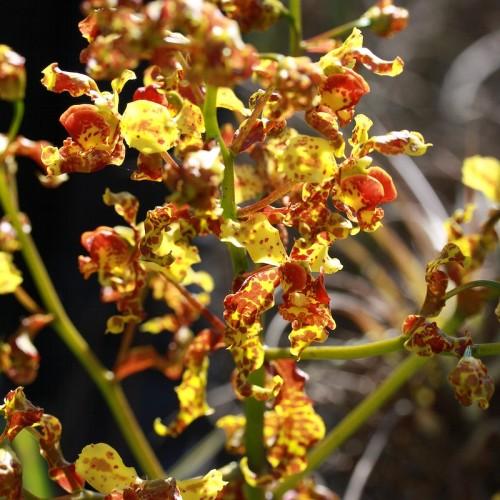
orchid
Oncidium (group)
Cycle:
Perennial
Watering:
Frequent
Hardiness Zone:
9 - 12
Flowers:
Flowers
Sun:
part sun/part shade
Leaf:
Yes
Growth Rate:
High
Maintenance:
Moderate
Drought Tolerant:
Yes
Salt Tolerant:
Yes
Indoors:
Yes
Care Level:
Medium
watering
Water your Oncidium orchids twice a week, making sure to water thoroughly each time. Allow the soil to become about 80-90% dry before watering. You may need to adjust the frequency and amount of water according to the season, temperature or the health of the plant. In the winter months, when plants are dormant, water less often. In warmer months, they may need an extra water or 2.
sunlight
Oncidium orchid species thrive best in bright, but indirect sunlight, which means that it should get bright, filtered light for about 8 to 12 hours per day. The best and most even light source for Oncidium orchids is filtered sunlight, like that found near an east- or southeast-facing window. Direct sunlight should be avoided, as the intense rays can burn the leaves.
pruning
Orchid (Oncidium (group)) plants require very little pruning; just a light trim is needed every few months to remove any dead or dying blooms and leaves. If your orchid is blooming, you can also carefully remove the old flower buds as they age. Pruning should also be done if you notice the plant becoming leggy and unkempt. The best time to prune your Oncidium orchid is in late summer or early autumn when it's finished flowering.
Season
Hardiness Map
FAQ
Are orchid plants hard to grow?
Orchid plants, while considered to be generally easier to grow than other varieties, can be quite challenging for many gardeners. Orchids require specific and controlled environmental conditions, such as the right soil, the right airspace, and the right amount of light and water. Without the proper care, orchids can become weak and prone to disease. Additionally, most orchids prefer temperatures that are cooler than those found in many homes, making them a bit more difficult to grow in some climates. With the right care and consideration, however, orchid plants can be possible to grow successfully and make very beautiful additions to any garden.
Can I repot my orchids?
Yes, you can repot your orchids. Though orchids can stay in the same pot for several years, repotting may be necessary if your orchid's roots have outgrown its pot, or if the soil is no longer providing adequate drainage or nutrients. When you're ready to repot, make sure to use a quality potting medium specifically designed for orchids as well as a pot that is slightly larger than the current one, as this will give the roots more room to grow. Additionally, handling the orchid gently and allowing it to recuperate in a shaded area after you’re finished will help ensure that your orchid will thrive.
Can I grow orchid plants indoors?
Yes, you can grow orchid plants indoors. Orchid plants make a lovely addition to any indoor space, and they’re easy to grow and maintain. To get started, make sure you maintain the right temperature and humidity levels, feed your orchid with a specially formulated orchid fertilizer, and keep your orchid in bright, indirect sunlight. When watering, make sure you use room-temperature water and allow the orchid to dry out between waterings. With the right care, you can enjoy your indoor orchid bloom for years to come.
Do orchids attract pollinators?
Yes, orchids do attract pollinators. In fact, they are famous for their intricate flower designs and vivid colors, which attract bees and other insects. They also produce fragrant, sweet-smelling odors to draw in pollinators from great distances. These tempting aromas can be found even in insect-pollinated orchid species like the wild ones found in jungles, deserts, and other habitats. Additionally, some orchid species have evolved kleptoparasitic modes of pollination, in which the pollinators have to steal nectar from the flowers, further driving pollination.
Do orchid flowers aromatic?
Yes, many orchid flowers produce a particularly sweet and fragrant scent. Different species of orchids produce a diverse variety of scents, ranging from a mild, sweet smell to a sophisticated, spicy scent. The scent can also be quite strong, depending on the type of orchid and the growing conditions. Some popular orchid flower types known for an outstanding scent include butterfly orchid, Lady's Slipper, fragrant dendrobium, and miniature cattleya.
Do orchids have long life?
Yes, orchids can have a very long life. A healthy plant can live up to fifty years. Furthermore, they can reproduce by re-blooming every spring, although most orchids need to be re-potted once a year. Taking good care of them, with proper watering, fertilizing and pruning, an orchid can thrive and bring beauty to your home for many, many years.
Is there any distinct blooming period for orchids plant?
Yes, orchids generally bloom for about 6-8 weeks during a given period of time. While there is no one specific blooming period for orchids, as it can depend on the variety and the climate, many tend to flower between February and April in cooler climates and from August to November in warmer climates. Some orchids may also bloom multiple times throughout the year. To ensure your orchid is blooming when you want it to, you can regulate the environment and care needs such as watering and light.
Is orchids plant used in holiculture's?
Yes, orchids are a popular plant in horticulture. They are prized for their delicate, colorful blooms, which come in a wide range of shapes, sizes, and colors. Not only do these plants have a unique beauty, but they are also easy to grow indoors. Their long lasting blooms make them perfect for both indoor and outdoor gardens. Orchids are also very versatile in that they can be grown in many different conditions, allowing them to be used in a variety of horticultural projects. Furthermore, orchids can even be grown in flower arrangements due to their long lasting blooms. All in all, orchids are a great choice for any horticulture project.
